|
|
If you are reading these rules for the first time, ignore the text along the right hand side. These rules serve as a summary to help you quickly familiarize yourself with the game.
Show
→ summary only
→ detailed version only
→ both summary and detailed version

Hellas
Hellas, 480BC. It’s the rise of classic Greek civilization. After a period of war
the Greek return to their country and continue the hard work at the islands.
The building and development of large cities is the next step into a new era.
Clarification about the implementation on Yucata:
- Points are immediately awarded during the game instead of at the end, except for the majority of rings and remaining marble.
- Marble cubes are visible for other players.
- A tie breaker is added: marble not used for scoring.
Game Components
1
4 victory point markers
48 houses
12 palaces
12 squares
4 player screens
40 quarry tiles
14 rings
3 statues
1 quarry worker
30 pillars
20 marble discs (worth 5)
50 marble cubes (worth 1)
12 action markers
Setup
Setup board

Place the game board in the middle of the table. Use the Minotaur board in a three- or four-player game.
Use the Pegasus board in a two-player game.
Place the quarry tiles face down next to the game board.
Place three quarry tiles face down on three random quarry fields on the coast of the island
and subsequently reveal them.
Place the quarry worker on a random unoccupied quarry field.
This can either be on a quarry on the coast or on the interior of the island.
Place the pillars, statues and the rings next to the game board.
Place the marble cubes and marble discs in a general supply next to the game board.
Each player gets five marble cubes and one marble disc (so all players start with a total worth of 10 marble).
Setup player
Each player chooses a colour and takes 1 player screen, 12 houses, 3 palaces, 3 squares and 1 marker in this colour.
Divide the 12 purple action markers equally among all players:
- In a two player game each player gets 6 markers.
- In a three player game each player gets 4 markers.
- In a four player game each player gets 3 markers.
Choose a starting player.
Objective
In this game players build villages and cities on the island close to quarries to
mine marble. They need this marble to develop their villages and cities, engage
in temple construction and build statues to honour the gods.
Expand your cities wisely and spend your marble the most efficient way and
you’ll have a good chance to win this game.
In this game players build villages and cities on the island close to quarries to
mine marble. They need this marble to develop their villages and cities, engage
in temple construction and build statues to honour the gods.
Some quarries will provide more marble than other quarries.
Once a quarry is closed no marble can be obtained from that quarry anymore.
Expand your cities wisely and spend your marble the most efficient way and
you’ll have a good chance to win this game.
Game sequence
The game is played over three rounds.
The active player chooses and places one of his action markers on a free
space of the action track on top of the game board.
There are two types of actions:
 Actions performed by all players or that affect all players. Actions performed by all players or that affect all players. Actions performed only by the player who has chosen the action. Actions performed only by the player who has chosen the action.
The chosen action is performed immediately.
A round ends when all players have used all of their action cubes.
The game is played over three rounds. Each round players use their action
markers to choose and perform actions.
Each round the starting player begins, then play continues in clockwise order.
The active player chooses and places one of his action markers on a free
space of the action track on top of the game board. Actions previously chosen
by any player this round have action markers on them and cannot be chosen
again this round.
There are two types of actions:
 Actions performed by all players or that affect all players. Actions performed by all players or that affect all players. Actions performed only by the player who has chosen the action. Actions performed only by the player who has chosen the action.
The chosen action is performed immediately.
Then the next player takes his turn.
A round ends when all players have used all of their action cubes.
Important: A player can also select an action and choose not to perform it
(e.g. if he cannot or does not want to pay the cost). If this concerns an action
which can only be performed by the active player ( ), nothing happens.
If this concerns an action which can be performed by all players ( ), nothing happens.
If this concerns an action which can be performed by all players ( ), the
remaining players still have the opportunity to perform the action. ), the
remaining players still have the opportunity to perform the action.
If another player cannot or does not want to perform the action in question,
he may also refrain from performing it.
Overview actions
Build a house: each player may build one house in his colour on a freespace on the board at a cost of 1 or 2 marble.

Build a house:
Starting with the active player and proceeding in clockwise order, each player may build one house in his colour on a free
space on the board. Houses cannot be built on temple or quarry spaces.
- To build a house on the coast of the island a player has to pay 1 marble.
- To build a house on the interior of the island a player has to pay 2 marble.
Build a house and/or a square: each player may build one house and/or one square in his colour on any free space on the board at a cost of 1 or 2 marble each.

Build a house and/or a square:
Starting with the active player and proceeding in clockwise order, each player may build one house and/or one
square in his colour on any free space on the board. If a player decides to build both buildings, he has to build them on two different free spaces.
The house and the square don’t have to be built on adjacent fields. Houses and squares cannot be built on temple or quarry spaces.
- To build a house or a square on the coast of the island a player has to pay 1 marble.
- To build a house or a square on the interior of the island a player has to pay 2 marble.
Build a palace: each player may build one palace in his colour on a free space on the board at a cost of 5 or 7 marble.

Build a palace:
Starting with the active player and proceeding in clockwise order, each player may build one palace in his colour on a free
space on the board. Palaces cannot be built on temple or quarry spaces.
- To build a palace on the coast of the island a player has to pay 5 marble.
- To build a palace on the interior of the island a player has to pay 7 marble.
Mine marble: each player gains marble for each of their houses next to an active quarry. Each house directly adjacent to an active quarry scores the amount of marble indicated.
Then the active player draws up to four quarry tiles. The active player must place these tiles on another active quarry with a lower number.
If the drawn tile can’t be placed on any active quarry, because all active
quarries have a higher number, the player must activate a new
quarry with the quarry worker on it.
The active player then moves the quarry worker to an empty quarry of their choice.
The quarry with the highest value on its top tile is now closed.

Mine marble:
Each player gains marble for each of their houses next to an active quarry.
There are always three active quarries on the board (quarries with a face up tile on its top).
For each house in their colour directly adjacent to these quarries each player gets the amount of marble indicated on the quarry’s top tile. Players who have several houses
adjacent to an active quarry gain marble for each house.
Important: Only houses next to a quarry produce marble. Palaces and
squares don’t produce marble.
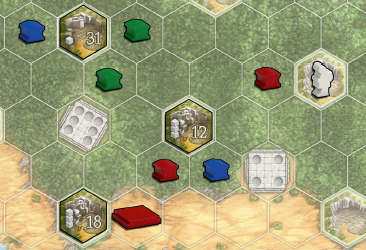
Example: Blue chooses the Mine marble action. He gets 4 marble (1+3).
Green gets 2 (1+1) marble and Red gets 3 marble.
Then the active player draws up to four quarry tiles. Quarry tiles are drawn
one by one. Draw a tile and reveal its number. The active player must place
this tile on another active quarry with a lower number on its top tile. If multiple
quarries are valid, the active player chooses one.
After placing this tile on top of an active quarry, the active player must draw
another tile and repeats the steps above. A player can place up to four quarry
tiles in one action. After placing the fourth tile the action automatically ends.
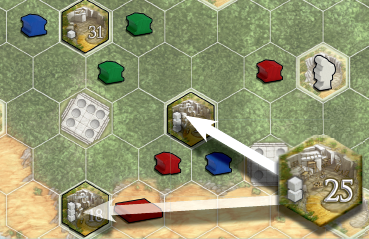
Important: The active player can’t refrain from revealing tiles after placing a
tile on an active quarry before having placed his fourth tile during his turn.
Example: The player reveals the value 25 quarry tile. This can be placed on
top of the 12 or 18 tile. He decides to place it on the 12 tile.
If the drawn tile can’t be placed on any active quarry, because all active
quarries have a higher number on their top tile, the player must activate a new
quarry by placing the tile on the quarry with the quarry worker on it.
The active player then moves the quarry worker to an empty quarry of their
choice.
The quarry with the highest value on its top tile is now closed. Turn the pile with
tiles on this quarry face down. It is no longer possible to mine any marble from
this quarry for the rest of the game.
After closing a quarry the action ends (even if the active player didn’t draw up to four tiles).
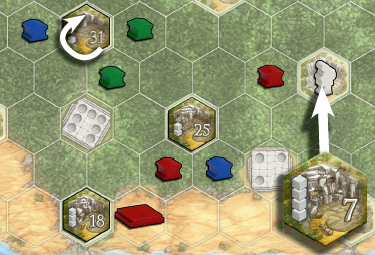
Example: The player reveals the value 7 quarry tile. This will activate a new
quarry, since none of the currently active quarries has a value of less than 7.
The quarry tile is placed on the quarry with the quarry worker on it. Then the
quarry with the highest value on its top (in this example: 31) will be closed.
All tiles on that quarry are turned face down. The active player’s turn ends.
Build temple: The active player may place pillars from the general supply in one or more temples and receives a ring.

Build temple:
The active player may place pillars from the general supply in one or more temples. This action is only performed by the active player.
There are three action spaces which allow a different number of pillars to be build:
- Pay 4 marble to build two pillars and receive one ring.
- Pay 6 marble to build three pillars and receive one ring.
- Pay 10 marble to build five pillars and receive one ring.
Important: The player has to build the exact number of pillars shown in the action space. If he cannot or doesn’t want to build this number
he must refrain from performing this action, nor does he receive a ring.
Each temple on the board has a different number of available spaces to build pillars on. Players can only build on free spaces in a temple.
The player who completes a temple by building the final pillar of the temple immediately receives an additional ring.
Important: The player can build pillars in any temple and is not obliged to build pillars in any unfinished temple first.
The first player to select this action in a round moves his marker from the “0” space on the score track to the appropriate field below the
chosen action. This indicates this player will be the starting player the next round, even if the player decides not to perform the action!
Build a statue: The active player may build a statue on a free space on the board.

Build a statue:
The active player may build a statue on a free space on the board. A statue cannot be built on a temple or quarry field or on
the coast of the island.
- To build a statue the player has to pay 7 marble.
Take three marble: The active player takes three marble from the general supply.

Take three marble:
The active player takes three marble from the general supply.
Founding a city
One or several directly adjacent houses of a player constitute a village. If a player builds a palace connected to one of their own villages, this village becomes a city.
Since each player has three palaces, they can build max. three independent cities in the course of the game.
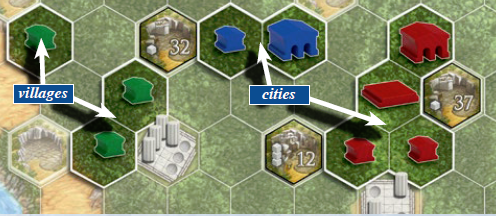
One or several directly adjacent houses of a player constitute a village.
If a player builds a palace next to one of their own villages, this village becomes
a city. It is allowed for players to build a palace on a space that is not adjacent
to a village. In this case a city will be founded when at least one house in the
same colour is built on an adjacent field or when a square in the same colour
connects that palace with a village of that colour.
Since each player has three palaces, they can build three independent cities in
the course of the game. A city can include two or three palaces. In addition, it
is allowed for players to merge two or three cities of the same colour into one
larger city in the course of the game. A city can expand on the game board
through the construction of additional houses, palaces and squares.
End of the round
When all players have used their action markers, the round ends.
At the start of the third round, players get one fewer action marker.
When all players have used their action markers, the round ends. Remove
all action markers from the action track and place them in the general supply.
The player whose marker is located below one of the temple building spaces
on the action track will be the starting player in the next round. His marker then
returns to the “0” space on the scoring track.
At the start of the second round divide all 12 action markers equally among all
players like in the first round.
At the start of the third round, players get one fewer action marker, so each
player gets 5 markers in a two player game, 3 markers in a three player game
and 2 markers in a four player game.
Game end
 Village Village |
0 VP |
 
Largest city of each player |
Each house, square and palace in this city: 1 VP |
 Temples Temples |
Each city adjacent to a temple: 1 VP / pillar in the temple. |
 Statue Statue |
Each city adjacent to a statue: 3 VP / statue. |
 Rings Rings |
Each ring: 2 VP
Most rings: +3 VP |
 Marble Marble |
Each 5 marble: 1 VP |
The game ends after the third round. Players use their marker to keep track of their points on the scoring track.
Players score victory points (VP) for:
- Their largest city: All houses, squares and palaces of the same colour belonging to the largest city of each player score 1 VP each.
Note: If a player has two equally sized largest cities, he only scores one city.
-
Temple: Each city adjacent to one or several temples is worth as many VP
as the total number of pillars present in the temple(s). If several cities are
adjacent to a temple, all involved cities get these VP.
Note: A village adjacent to a temple doesn’t score VP.
-
Statues: Each city scores 3 VP for each adjacent statue. If several cities are
adjacent to a statue, all involved cities score 3 VP.
Note: A village adjacent to a statue doesn’t score VP.
-
Rings: Each ring is worth 2 VP. The player with the most rings scores
3 additional VP. In case of a tie, each of the tied players scores the 3 additional VP.
- Marble: Players score 1 VP for every 5 of their marble.
The player with the most victory points wins the game. In case of a tie the victory is shared by the tied players.
The tie breaker is the marble left that was not used for scoring.
Example: a player ending the game with 7 marble will have (7 - 5) 2 marble left for the tie breaker.
Example:
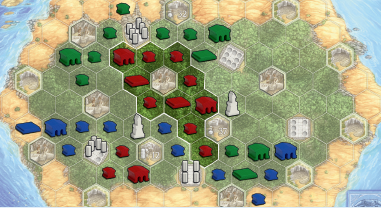
Red’s largest city consists of 6 houses, 2 squares and 2 palaces.
He scores 10 VP.
A red city is adjacent to 2 statues. Another red city is also adjacent to one of
these statues. Red scores 9 VP. Blue has only one city adjacent to a statue,
so he scores 3 VP.
The red cities are adjacent to three temples. The 4-pillar temple
and the 6-pillar temple are complete. The 8-pillar temple only consists of
5 columns. Red scores 15 VP. Two green cities are adjacent to a complete
6-pillar temple. Green scores 12 VP. Blue has one city adjacent to a temple
and scores 5 VP.
Green has 2 rings. As another player has more rings, Green scores 4 VP.
The red player has 18 marble at the end of the game. Red scores 3 VP.
| |